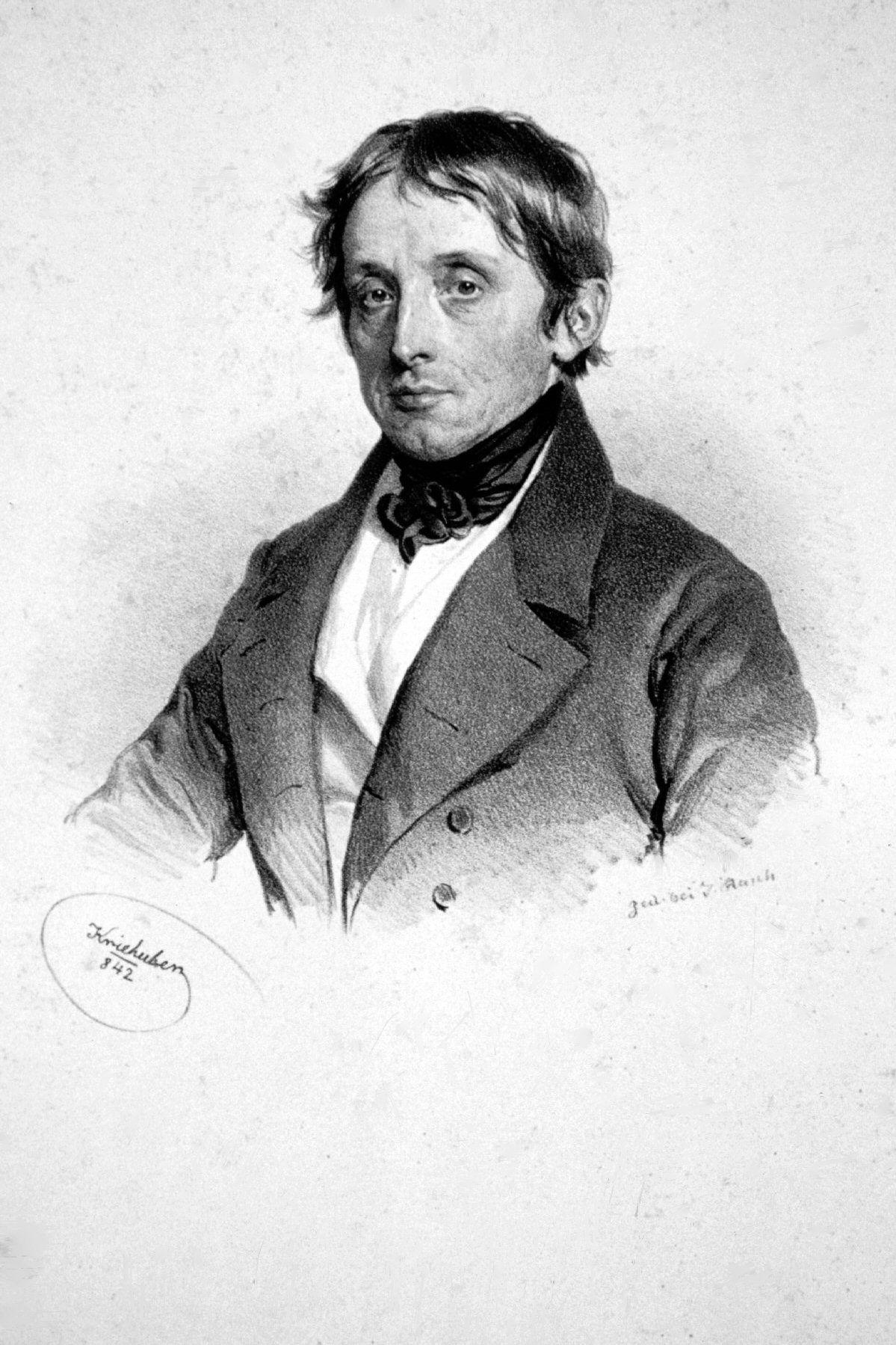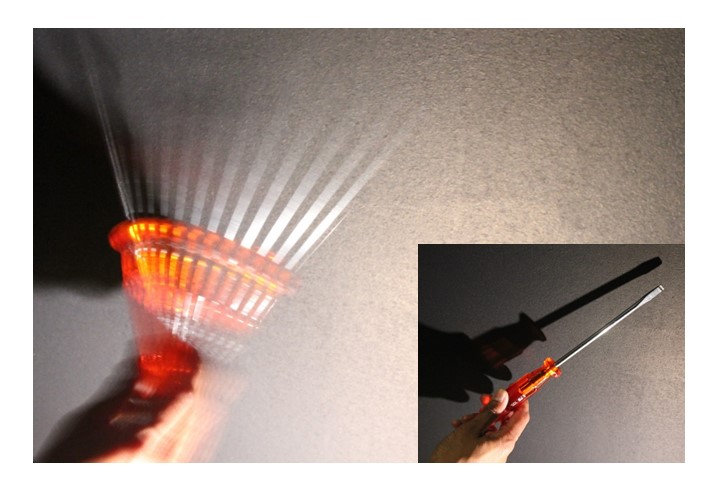|
Simon Ritter Von Stampfer
Simon Ritter von Stampfer (26 October 1792 (according to other sources 1790)), in Windisch-Mattrai, Archbishopric of Salzburg today called Matrei in Osttirol, Tyrol – 10 November 1864 in Vienna) was an Austrian mathematician, surveyor and inventor. His most famous invention is that of the stroboscopic disk which has a claim to be the first device to show moving images. Almost simultaneously similar devices were produced independently in Belgium (the phenakistiskop), and Britain (the Dædaleum, years later to appear as the Zoetrope). Life Youth and education Simon Ritter von Stampfer was born in Matrei in Osttirol, and was the first son of Bartlmä Stampfer, a weaver. From 1801 he attended the local school and in 1804 and moved to the Franciscan Gymnasium in Lienz, where he studied until 1807. From there he went to the Lyceum in Salzburg, to study philosophy, however he was not assessed. In 1814 in Munich, he passed the state examination and applied there as a te ... [...More Info...] [...Related Items...] OR: [Wikipedia] [Google] [Baidu] |
Simon Stampfer Litho
Simon may refer to: People * Simon (given name), including a list of people and fictional characters with the given name Simon * Simon (surname), including a list of people with the surname Simon * Eugène Simon, French naturalist and the genus authority ''Simon'' * Tribe of Simeon, one of the twelve tribes of Israel Places * Şimon ( hu, links=no, Simon), a village in Bran Commune, Braşov County, Romania * Șimon, a right tributary of the river Turcu in Romania Arts, entertainment, and media Films * ''Simon'' (1980 film), starring Alan Arkin * ''Simon'' (2004 film), Dutch drama directed by Eddy Terstall Games * ''Simon'' (game), a popular computer game * Simon Says, children's game Literature * ''Simon'' (Sutcliff novel), a children's historical novel written by Rosemary Sutcliff * Simon (Sand novel), an 1835 novel by George Sand * ''Simon Necronomicon'' (1977), a purported grimoire written by an unknown author, with an introduction by a man identified only as "Simo ... [...More Info...] [...Related Items...] OR: [Wikipedia] [Google] [Baidu] |
Kremsmünster Abbey
Kremsmünster Abbey (german: Stift Kremsmünster) is a Benedictine monastery in Kremsmünster in Upper Austria. History The monastery was founded in 777 AD by Tassilo III, Duke of Bavaria. According to the foundation legend, Tassilo founded the monastery on the site where his son, Gunther, had been attacked and killed by a wild boar during a hunting trip. The first colony of monks came from Lower Bavaria, under Fateric, the first abbot. The new foundation received generous endowments from the founder and also from Charlemagne and his successors. The position and reputation of the abbey soon became such that its abbots, in the absence of the bishop of the diocese (Passau), exercised the episcopal jurisdiction. In the 10th century the abbey was destroyed in a raid by the Hungarians, and its possessions were divided among the Duke of Bavaria and other nobles and the bishops. It was restored, however, and recovered its property, under the emperor Henry II, when Saint Gotthard bec ... [...More Info...] [...Related Items...] OR: [Wikipedia] [Google] [Baidu] |
Stroboscopic Effect
The stroboscopic effect is a visual phenomenon caused by aliasing that occurs when continuous rotational or other cyclic motion is represented by a series of short or instantaneous samples (as opposed to a continuous view) at a sampling rate close to the period of the motion. It accounts for the "wagon-wheel effect", so-called because in video, spoked wheels (such as on horse-drawn wagons) sometimes appear to be turning backwards. A strobe fountain, a stream of water droplets falling at regular intervals lit with a strobe light, is an example of the stroboscopic effect being applied to a cyclic motion that is not rotational. When viewed under normal light, this is a normal water fountain. When viewed under a strobe light with its frequency tuned to the rate at which the droplets fall, the droplets appear to be suspended in mid-air. Adjusting the strobe frequency can make the droplets seemingly move slowly up or down. Stroboscopic principles, and their ability to create an illusio ... [...More Info...] [...Related Items...] OR: [Wikipedia] [Google] [Baidu] |
Simon Stampfer 1853 Litho
Simon may refer to: People * Simon (given name), including a list of people and fictional characters with the given name Simon * Simon (surname), including a list of people with the surname Simon * Eugène Simon, French naturalist and the genus authority ''Simon'' * Tribe of Simeon, one of the twelve tribes of Israel Places * Şimon ( hu, links=no, Simon), a village in Bran Commune, Braşov County, Romania * Șimon, a right tributary of the river Turcu in Romania Arts, entertainment, and media Films * ''Simon'' (1980 film), starring Alan Arkin * ''Simon'' (2004 film), Dutch drama directed by Eddy Terstall Games * ''Simon'' (game), a popular computer game * Simon Says, children's game Literature * ''Simon'' (Sutcliff novel), a children's historical novel written by Rosemary Sutcliff * Simon (Sand novel), an 1835 novel by George Sand * ''Simon Necronomicon'' (1977), a purported grimoire written by an unknown author, with an introduction by a man identified only as "Simon" ... [...More Info...] [...Related Items...] OR: [Wikipedia] [Google] [Baidu] |
Film
A film also called a movie, motion picture, moving picture, picture, photoplay or (slang) flick is a work of visual art that simulates experiences and otherwise communicates ideas, stories, perceptions, feelings, beauty, or atmosphere through the use of moving images. These images are generally accompanied by sound and, more rarely, other sensory stimulations. The word "cinema", short for cinematography, is often used to refer to filmmaking and the film industry, and to the art form that is the result of it. Recording and transmission of film The moving images of a film are created by photography, photographing actual scenes with a movie camera, motion-picture camera, by photographing drawings or miniature models using traditional animation techniques, by means of computer-generated imagery, CGI and computer animation, or by a combination of some or all of these techniques, and other visual effects. Before the introduction of digital production, series of still imag ... [...More Info...] [...Related Items...] OR: [Wikipedia] [Google] [Baidu] |
Phenakistiscope
The phenakistiscope (also known by the spellings phénakisticope or phenakistoscope) was the first widespread animation device that created a fluent illusion of motion. Dubbed and ('stroboscopic discs') by its inventors, it has been known under many other names until the French product name became common (with alternative spellings). The phenakistiscope is regarded as one of the first forms of moving media entertainment that paved the way for the future motion picture and film industry. Like a GIF animation, it can only show a short continuous loop. Etymology and spelling When it was introduced in the French newspaper ''Le Figaro'' in June 1833, the term 'phénakisticope' was explained to be from the root Greek word ''phenakistikos'' (or rather from φενακίζειν ''phenakizein''), meaning "deceiving" or "cheating", and ὄψ ''óps'', meaning "eye" or "face", so it was probably intended loosely as 'optical deception' or 'optical illusion'. The term phénakisticop ... [...More Info...] [...Related Items...] OR: [Wikipedia] [Google] [Baidu] |
Joseph Antoine Ferdinand Plateau
Joseph Antoine Ferdinand Plateau (14 October 1801 – 15 September 1883) was a Belgian physicist and mathematician. He was one of the first people to demonstrate the illusion of a moving image. To do this, he used counterrotating disks with repeating drawn images in small increments of motion on one and regularly spaced slits in the other. He called this device of 1832 the phenakistiscope. Biography Plateau was born in Brussels. His father, Antoine Plateau ( fr) born in Tournai, was a talented flower painter. At the age of six, the younger Plateau already could read, making him a child prodigy in those times. While attending primary school, he was particularly impressed by a lesson of physics; enchanted by the experiments he observed, he vowed to discover their secrets someday. Plateau spent his school holidays in Marche-les-Dames, with his uncle and his family; his cousin and playfellow was Auguste Payen, who later became an architect and the principal designer of the Belgian ... [...More Info...] [...Related Items...] OR: [Wikipedia] [Google] [Baidu] |
Ancient Greek
Ancient Greek includes the forms of the Greek language used in ancient Greece and the ancient world from around 1500 BC to 300 BC. It is often roughly divided into the following periods: Mycenaean Greek (), Dark Ages (), the Archaic period (), and the Classical period (). Ancient Greek was the language of Homer and of fifth-century Athenian historians, playwrights, and philosophers. It has contributed many words to English vocabulary and has been a standard subject of study in educational institutions of the Western world since the Renaissance. This article primarily contains information about the Epic and Classical periods of the language. From the Hellenistic period (), Ancient Greek was followed by Koine Greek, which is regarded as a separate historical stage, although its earliest form closely resembles Attic Greek and its latest form approaches Medieval Greek. There were several regional dialects of Ancient Greek, of which Attic Greek developed into Koine. Dia ... [...More Info...] [...Related Items...] OR: [Wikipedia] [Google] [Baidu] |
Stroboscope
A stroboscope, also known as a strobe, is an instrument used to make a cyclically moving object appear to be slow-moving, or stationary. It consists of either a rotating disk with slots or holes or a lamp such as a flashtube which produces brief repetitive flashes of light. Usually, the rate of the stroboscope is adjustable to different frequencies. When a rotating or vibrating object is observed with the stroboscope at its vibration frequency (or a submultiple of it), it appears stationary. Thus stroboscopes are also used to measure frequency. The principle is used for the study of rotating, reciprocating, oscillating or vibrating objects. Machine parts and vibrating string are common examples. A stroboscope used to set the ignition timing of internal combustion engines is called a timing light. Mechanical In its simplest mechanical form, a stroboscope can be a rotating cylinder (or bowl with a raised edge) with evenly spaced holes or slots placed in the line of si ... [...More Info...] [...Related Items...] OR: [Wikipedia] [Google] [Baidu] |
Michael Faraday
Michael Faraday (; 22 September 1791 – 25 August 1867) was an English scientist who contributed to the study of electromagnetism and electrochemistry. His main discoveries include the principles underlying electromagnetic induction, diamagnetism and electrolysis. Although Faraday received little formal education, he was one of the most influential scientists in history. It was by his research on the magnetic field around a conductor carrying a direct current that Faraday established the concept of the electromagnetic field in physics. Faraday also established that magnetism could affect rays of light and that there was an underlying relationship between the two phenomena.. the 1911 Encyclopædia Britannica. He similarly discovered the principles of electromagnetic induction, diamagnetism, and the laws of electrolysis. His inventions of electromagnetic rotary devices formed the foundation of electric motor technology, and it was largely due to his efforts t ... [...More Info...] [...Related Items...] OR: [Wikipedia] [Google] [Baidu] |
Stampfer Disc
Stampfer is a German language surname. Notable people with the surname include: * Simon von Stampfer (1792 (1790) – 1864), Austrian mathematician * Yehoshua Stampfer (1852–1908), one of the founders of Petah Tikva in Israel * Shaul Stampfer Shaul Stampfer (born 1948) is a researcher of East European Jewry specializing in Lithuanian yeshivas, Jewish demography, migration and education. Biography Shaul Stampfer was born in Atlanta, Georgia, to a Jewish family, and is a descendant of ... (born 1948), American Jewish historian * Wolfgang Stamppfer (born 1972), Austrian bobsledder See also * 3440 Stampfer, main-belt asteroid {{surname, Stampfer ... [...More Info...] [...Related Items...] OR: [Wikipedia] [Google] [Baidu] |





